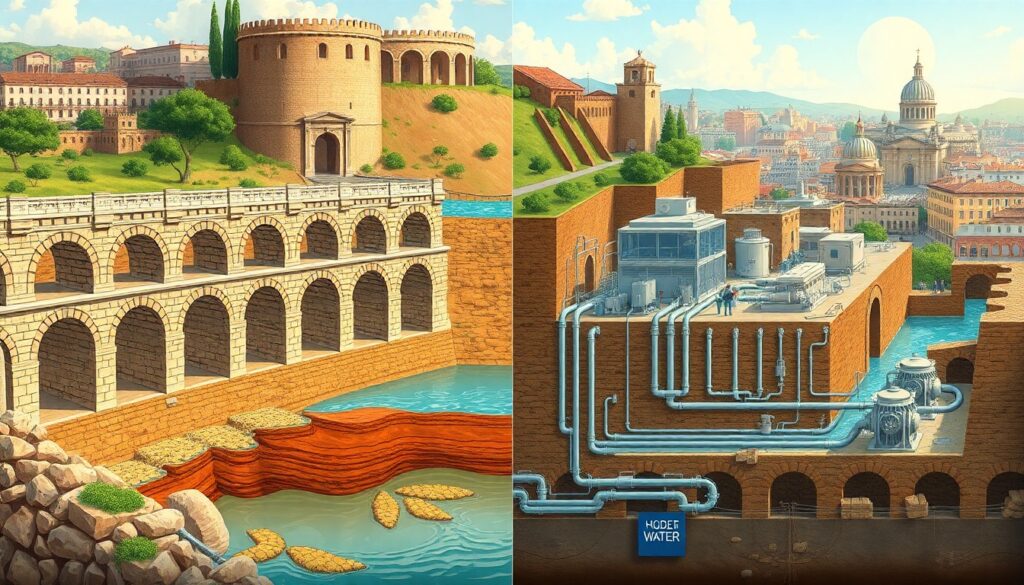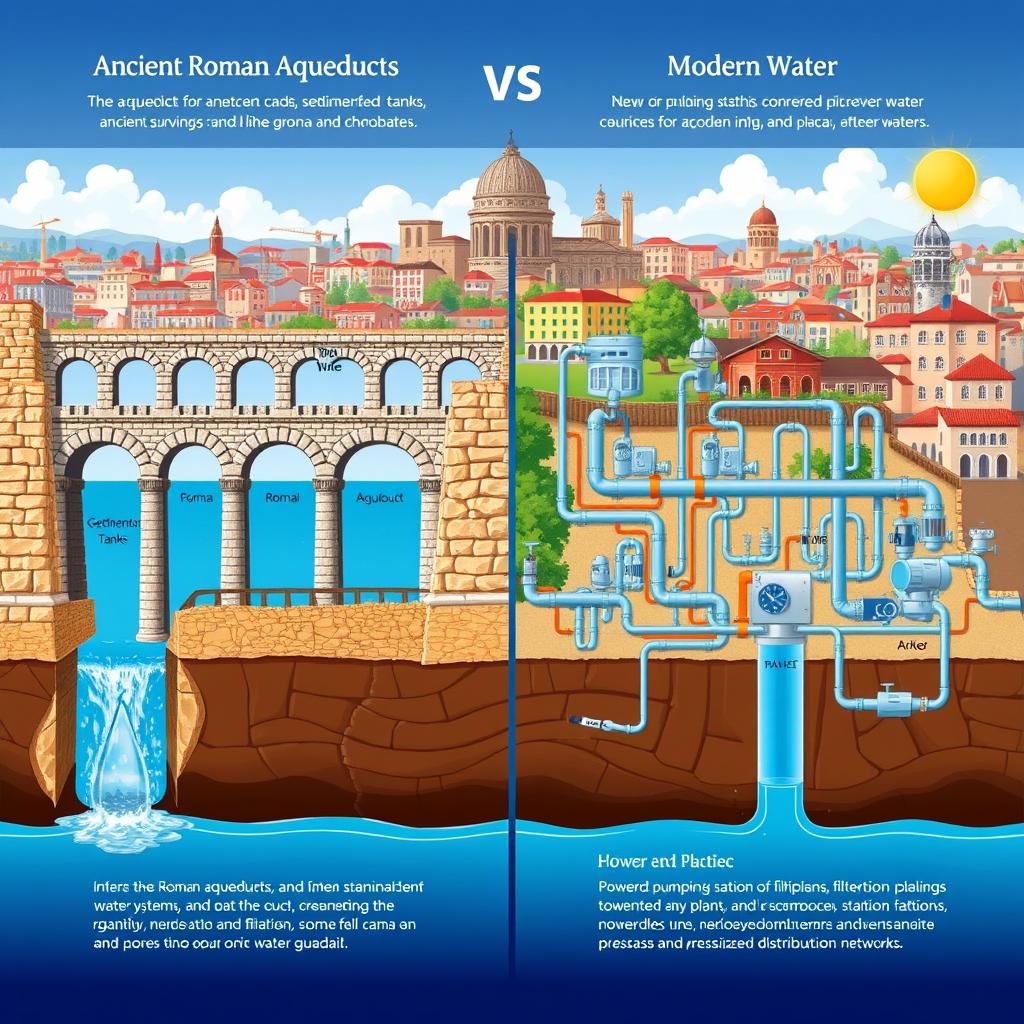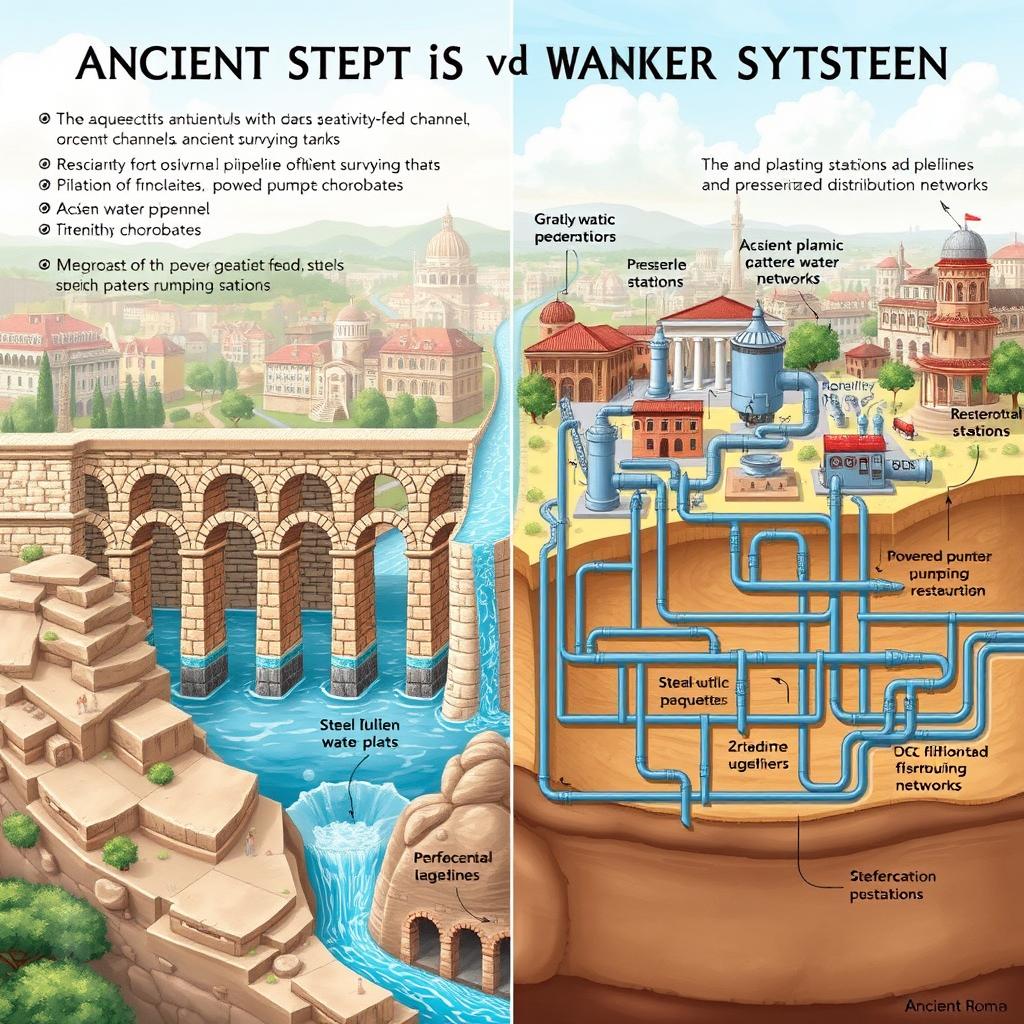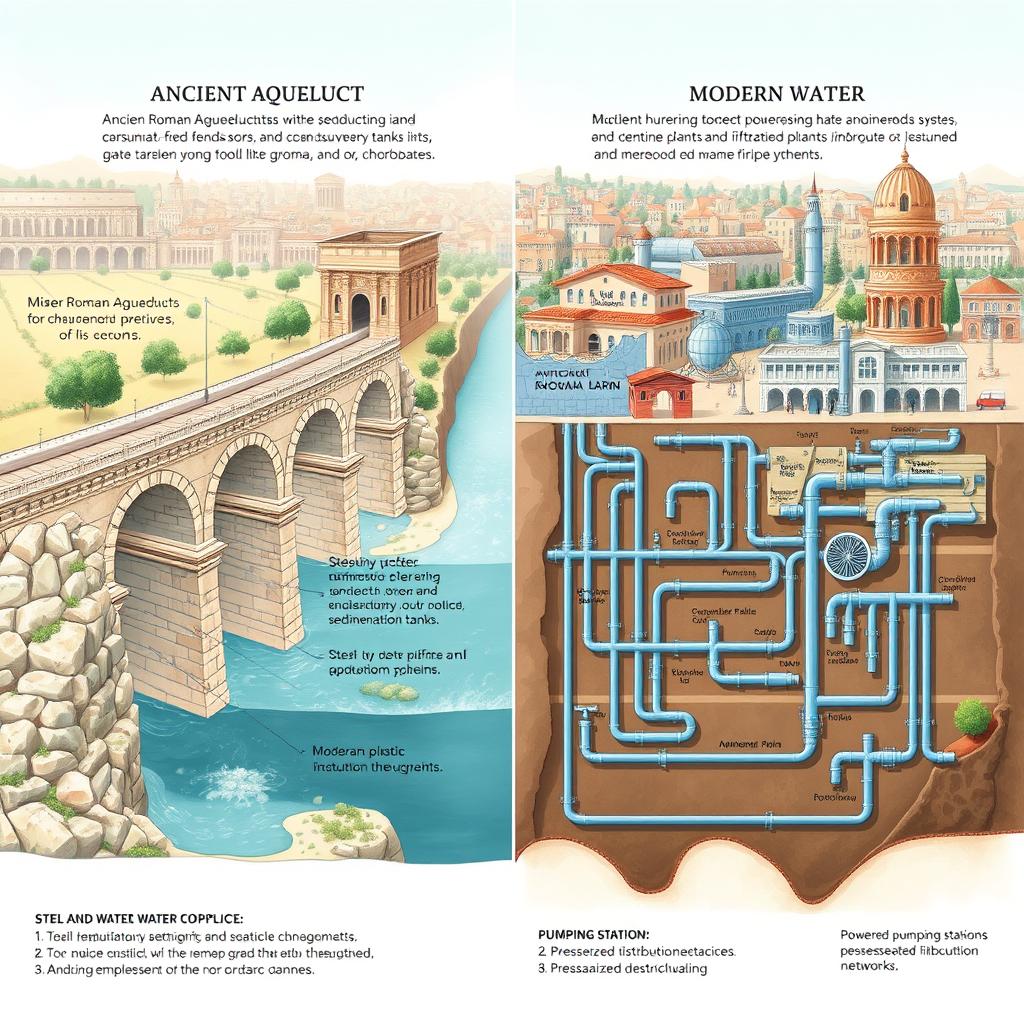Water infrastructure has always played a crucial role in the growth and sustainability of urban centers. The Roman aqueducts, which are part of the remarkable engineering feats from ancient Rome, were designed to channel fresh water across long distances using gravity alone. These systems not only supported cities with drinking water, irrigation, and public amenities but also shaped early urban development. For an immersive experience into this aspect of Roman history, one might even consider exploring role-playing games like Second Life, where users can delve into the world of ancient Rome.
In contrast, modern water systems rely on advanced technologies like powered pumping stations, durable materials, and complex distribution networks. They serve vastly larger populations with increased efficiency and capacity.
Roman Aqueducts vs. Modern Water Systems: What Can We Learn? invites you to explore:
- The historical significance of Roman aqueducts
- Innovations driving today’s water infrastructure
- Lessons from ancient techniques that remain relevant
Understanding the evolution from gravity-fed conduits to high-capacity pipelines reveals insights into sustainable design, resource management, and infrastructure resilience essential for future urban planning.
The historical significance of Roman aqueducts is deeply intertwined with the broader narrative of the Rise and Fall of the Roman Empire, a civilization that has left an indelible mark on the world. The daily life during this era was vastly different for various social classes, a topic explored in-depth in our analysis on Daily Life in Ancient Rome: The Social Class Divide.
Moreover, the principles derived from Roman Law, which originated around 753 BCE and lasted until the 5th century CE, continue to shape modern legal systems today. This is highlighted by the enduring influence of documents like the Corpus Juris Civilis, a comprehensive codification commissioned by Emperor Justinian I in the 6th century AD.

Historical Overview of Roman Aqueducts
The construction of Roman aqueducts was an incredible feat of engineering in ancient times. These structures were built to transport freshwater to cities, serving various needs such as drinking water, irrigation for agriculture, public fountains, and baths. The aqueduct systems played a vital role in sustaining the growing urban populations and supporting the overall development of Roman civilization.
Key Components of Roman Aqueducts
The aqueducts consisted of several intricate parts that were essential for their proper functioning:
- Conduits: These were channels made of materials like stone, brick, concrete, or lead that carried water over long distances while ensuring its cleanliness.
- Arcades: These architectural features supported the conduits as they crossed valleys and uneven landscapes, showcasing advanced building techniques.
- Sedimentation tanks: These tanks were designed to remove impurities from the water before it was distributed to various locations.
Notable Examples of Roman Aqueducts
Several aqueducts stand out as remarkable examples of Roman engineering:
- Aqua Appia: Built in 312 BCE, it was the earliest known aqueduct and a groundbreaking achievement in hydraulic engineering.
- Aqua Marcia: Renowned for its length, this aqueduct supplied water to Rome from distant sources.
- Aqua Claudia: This aqueduct provided water to Emperor Nero’s opulent Golden House.
- Aqua Virgo: Famous for supplying water to iconic landmarks like the Trevi Fountain, it remains an enduring symbol of Roman ingenuity.
The ingenuity and scale of these aqueducts reflect the Romans’ mastery of hydraulic principles and meticulous craftsmanship in constructing enduring water supply systems that shaped the development of ancient cities. This mastery is evident in their water delivery infrastructure, which included not just aqueducts but also sophisticated hydrology practices that ensured efficient and effective distribution of water throughout the empire.
Engineering Principles Behind Roman Aqueducts
Roman aqueducts, a testament to the innovative engineering of ancient Rome, relied heavily on the principle of gravity flow to transport water over long distances. This method required a precise and consistent gradient, usually a very slight downward slope, to keep water moving steadily without the need for pumps or other mechanical devices. The gradient often ranged between 0.15% and 0.3%, carefully balanced to avoid stagnation or excessive velocity that could damage the structure.
Key Engineering Techniques
Some key engineering techniques used in the construction of Roman aqueducts included:
- Gravity-fed channels: Water flowed naturally from higher elevations such as mountain springs or reservoirs to urban centers by following the contours of the land.
- Use of conduits with minimal friction: Smooth materials like stone, concrete, and sometimes lead pipes reduced resistance within channels.
Advanced Surveying Tools for Precision
The Romans employed advanced surveying tools to achieve this precision in route planning:
- Groma: A simple instrument used for establishing straight lines and right angles, essential for aligning aqueduct paths.
- Chorobates: A leveling device resembling a wooden bench with a water trough, used to measure slight gradients accurately over long distances.
- Dioptra: An early version of the modern theodolite, enabling detailed angular measurements necessary for navigating varied terrain.
These tools allowed engineers to design routes that balanced elevation changes with natural obstacles, including valleys and hills. When valleys were too deep for simple channeling, they employed siphons made from lead pipes encased in concrete sleeves, demonstrating sophisticated adaptation within their gravity-based system.
Sustainable Engineering Practices
Roman engineers’ mastery of these principles ensured reliable water delivery without energy-intensive methods, showcasing early sustainable engineering practices still relevant today.

Maintenance and Legal Frameworks in Ancient Rome
The maintenance and legal frameworks surrounding Roman aqueducts played a crucial role in ensuring the longevity and efficiency of these sophisticated water systems. Here are the key points to consider:
1. Systems for Regular Maintenance
- Roman engineers implemented systematic maintenance schedules to inspect, repair, and clean aqueducts regularly.
- Skilled workers were employed to monitor the flow of water, address leaks or blockages, and perform necessary upkeep tasks.
- Maintenance crews were well-versed in the construction techniques and materials used in aqueducts to facilitate efficient repairs.
2. Legal Rules Protecting Infrastructure
- Ancient Rome had strict laws safeguarding aqueducts from damage, sabotage, or unauthorized interference.
- Penalties for tampering with or polluting the water supply were severe to deter misuse or neglect.
- Legal provisions ensured that aqueducts were considered vital public assets, warranting protection and preservation for the benefit of all citizens. These legal frameworks can be traced back to significant milestones such as The Twelve Tables, which were the first attempt to codify the complex legal practices of ancient Rome.
By combining robust maintenance practices with stringent legal protections, Roman aqueducts exemplified a holistic approach to infrastructure management that prioritized functionality, durability, and societal welfare. These principles continue to offer valuable insights for modern water systems seeking sustainable operation and resource conservation.
Moreover, the intricacies of ancient Roman life extended beyond infrastructure management. The entertainment sector was also a significant part of society, influencing social relationships and political authority. The legacy of Ancient Rome remains a cornerstone of Western civilization, with its impact seen in various aspects of modern society as detailed on our comprehensive Men of Pompeii website.

Overview of Modern Water Systems
Modern water systems have evolved significantly from ancient Roman aqueducts. These systems now incorporate a combination of pipelines and pumping stations to deliver water efficiently across vast distances. The use of advanced materials like steel and plastic pipes ensures durability and reliability in water transportation.
Pipelines in Modern Water Systems
Steel and plastic pipes are commonly used in modern aqueducts due to their strength and longevity. These pipelines are designed to withstand high pressure and transport large volumes of water to meet the demands of growing urban populations.
Pumping Stations in Modern Water Systems
Powered pumping stations play a crucial role in modern water infrastructure, allowing for the transportation of water over long distances. These stations provide the necessary energy to move water uphill or across flat terrain, supplementing gravity-fed systems for enhanced efficiency.
Filtration Plants and Pressurized Systems
Modern water systems are equipped with filtration plants to ensure the delivery of clean and potable water to consumers. Pressurized systems help maintain consistent water pressure throughout the distribution network, optimizing the flow of water to end-users.
Modern water systems represent a technological leap forward from ancient aqueducts, showcasing advancements in materials, pumping technology, and distribution methods to meet the complex needs of contemporary urban environments.
Technological Advancements in Modern Water Infrastructure
Modern water infrastructure has seen significant technological advancements compared to the gravity-dependent systems of ancient Rome. Two key developments have revolutionized the efficiency and capacity of modern water systems:
1. Powered Pumps
The shift from relying solely on gravity to using powered pumps has increased the capacity and flexibility of water transport systems.
- Enhanced Capacity: Powered pumps can transport larger volumes of water over longer distances, meeting the needs of growing urban populations more effectively.
- Flexibility: Pumping stations allow for more precise control over water flow and pressure, adapting to fluctuating demand and ensuring consistent supply.
2. Advanced Materials
Modern water infrastructure utilizes advanced materials like steel and plastic pipes that enhance durability and longevity.
- Durability: These materials are designed to withstand harsh conditions and resist corrosion, ensuring a longer lifespan for water pipelines.
- Efficiency: The use of advanced materials also improves the efficiency of water transport, reducing leakages and ensuring a more sustainable delivery system.
These technological advancements have not only increased the scale and capacity of modern water systems but have also improved their reliability, resilience, and overall performance.
Comparing Scale and Capacity: Then vs. Now
Quantitative Comparison
The Roman aqueducts had an impressive ability to transport water over distances of about 92 kilometers, showcasing the innovative engineering skills of the ancient Romans. In comparison, modern water systems have greatly exceeded this range, with some systems capable of transporting water over distances greater than 700 kilometers. This significant increase in coverage highlights the advancements in technology and infrastructure over the years.
Water Volume Transport
Roman aqueducts were limited in their ability to transport large amounts of water because they relied on gravity for flow. On the other hand, modern water systems use pumping stations to move large quantities of water efficiently and quickly, meeting the needs of densely populated urban areas with high water demands.
Distance Coverage
The limited reach of Roman aqueducts meant that only certain areas could benefit from their water supply networks. However, modern water systems have a much wider reach, spanning hundreds of kilometers and providing clean water to vast regions. This is crucial for supporting millions of people and sustaining urban development on a large scale.
By comparing the scale and capacity of Roman aqueducts with modern water systems, we can appreciate the evolution of water infrastructure technology and understand the significant advancements that have allowed us to meet the increasing demands of today’s societies.

Lessons from Roman Aqueducts for Modern Water Systems
Roman aqueducts exemplify sustainable design principles that remain relevant today. Their reliance on gravity-fed water transport significantly reduced energy consumption, as no external power was needed to move water across long distances. Modern systems can benefit by incorporating gravity-fed sections where topography allows, cutting down on operational costs and environmental impact.
Durable construction methods used by the Romans also offer valuable insights. Materials such as stone, concrete, and lead pipes were chosen for longevity, enabling aqueducts to function for centuries with proper maintenance. Modern infrastructure often emphasizes short-term efficiency, but adopting durable construction techniques enhances resilience against wear and reduces the need for frequent repairs.
Key takeaways include:
- Maximizing natural gradients to minimize energy use in water transport
- Prioritizing materials and designs that withstand time and environmental pressures
- Designing infrastructure that balances technological advancements with core principles of sustainability
These lessons encourage a holistic approach to water system design—one that values both innovation and the proven wisdom of ancient engineering.
Public Resource Management Insights
Roman aqueducts were not just feats of engineering; they exemplified sophisticated governance models and legal frameworks that regulated water as a vital public resource. These frameworks ensured both equitable access to water and protection of the infrastructure itself.
Key aspects of Roman public resource management:
Legal Protections: The lex aquilia and other laws imposed strict penalties on anyone who damaged aqueducts, reflecting the high value placed on preserving water supply infrastructures. Unauthorized tapping or pollution was punishable, deterring misuse.
Access Regulation: Water distribution was controlled through official permissions. The curator aquarum, an appointed official, oversaw maintenance, allocation, and resolved disputes, effectively managing demand and preventing monopolization.
Maintenance Obligations: Regular inspections and repairs were mandated by law. Citizens and contractors involved in construction and upkeep faced accountability measures to maintain system integrity.
Public vs. Private Rights: While major aqueducts were public assets funded by the state or emperors, private users could obtain authorized connections under regulated conditions, balancing public benefit with individual needs.
This blend of governance ensured water remained a shared community asset rather than a commodity for exclusive interests. Such ancient legal frameworks highlight the importance of institutional oversight in sustaining complex urban water systems—an insight modern water management can draw upon to enhance fairness and infrastructure longevity.
Moreover, the regulation of such a crucial resource like water also reflects broader social dynamics within Roman society. Understanding the lives of plebeians, who represented the majority of the population, is essential for grasping these dynamics. They significantly influenced the development of political and economic structures in Rome.
On the other hand, the patricians, the wealthy elite, had different stakes in this system. Their distinct position often led to a concentration of resources and power, which could affect public resource management.
Such societal structures also left their imprint on art and culture in ancient Rome. The artistic expressions from this period were heavily influenced by these social dynamics, showcasing a civilization that thrived from 753 BC to 476 AD with remarkable ingenuity and creativity.
Integrating Ancient Wisdom with Modern Technology
The comparison of Roman Aqueducts vs. Modern Water Systems: What Can We Learn? highlights opportunities for hybrid engineering approaches that blend ancient gravity-fed concepts with contemporary pumping technologies. Such integration can drive advances in sustainable urban water management by balancing energy efficiency and system flexibility.
Benefits of Combining Gravity-Based Principles with Modern Pumps
- Energy Reduction: Gravity-driven flows minimize reliance on electrically powered pumps, cutting down operational energy demands. Strategic use of gravity in downhill sections can offset the need for continuous pumping.
- System Resilience: Gravity-fed segments provide natural failsafe pathways during power outages or pump failures, enhancing reliability especially in emergency situations.
- Cost Savings: Lower energy consumption translates to reduced utility expenses and maintenance costs over the long term.
- Environmental Impact: Reducing electrical pumping reduces carbon emissions linked to energy production, supporting greener infrastructure goals.
Practical Applications
Modern water systems can incorporate:
- Gravity-assisted pipelines where terrain allows, using pumps only to overcome uphill stretches or pressure losses.
- Storage reservoirs elevated above city distributions to create gravitational pressure heads instead of fully pressurized pump stations.
- Intelligent control systems that optimize pump operation in real time, leveraging gravity flow whenever feasible.
Roman aqueducts excelled by harnessing the natural landscape’s topography for steady water transport without external energy inputs. By revisiting these principles within modern design frameworks, engineers can build more sustainable and efficient urban water networks that meet growing population demands while conserving resources.
These hybrid strategies demonstrate how ancient engineering wisdom still holds relevance and value when combined thoughtfully with modern technology. They encourage a holistic approach—one that respects both historical insights and contemporary innovations—to address today’s challenges in urban water supply.
Conclusion
The comparison of Roman Aqueducts vs. Modern Water Systems: What Can We Learn? highlights critical historical lessons that remain relevant for future water infrastructure development. The Romans demonstrated the value of:
- Sustainability through gravity-fed designs that minimized energy use
- Durability with long-lasting materials and robust construction methods
- Legal frameworks protecting public access and system integrity
- Maintenance regimes ensuring continuous operation over centuries
Modern systems, while technologically advanced and capable of handling vast volumes, can benefit from these ancient principles by integrating energy-efficient gravity flow where possible and emphasizing longevity in design choices. Water infrastructure projects should prioritize not only capacity and flexibility but also environmental impact and resilience.
Water is a precious resource requiring thoughtful stewardship. Embracing lessons from Roman aqueducts encourages a balanced approach combining innovation with proven wisdom to meet the challenges of urban growth and climate change sustainably.

